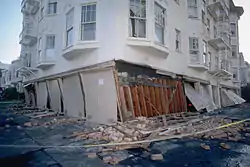Soft story building
A soft story building is a multi-story building in which one or more floors have windows, wide doors, large unobstructed commercial spaces, or other openings in places where a shear wall would normally be required for stability as a matter of earthquake engineering design.[1][2] A typical soft story building is an apartment building of three or more stories located over a ground level with large openings, such as a parking garage or series of retail businesses with large windows.[3]

Buildings are classified as having a soft story if that level is less than 70% as stiff as the floor immediately above it, or less than 80% as stiff as the average stiffness of the three floors above it.[4] Soft story buildings are vulnerable to collapse in a moderate to severe earthquake in a phenomenon known as soft story collapse.[5] The inadequately-braced level is relatively less resistant than surrounding floors to lateral earthquake motion, so a disproportionate amount of the building's overall side-to-side drift is focused on that floor. Subject to disproportionate lateral stress, and less able to withstand the stress, the floor becomes a weak point that may suffer structural damage or complete failure, which in turn results in the collapse of the entire building.[4]
Soft story failure was responsible for nearly half of all homes that became uninhabitable in California's Loma Prieta earthquake of 1989, and was projected to cause severe damage and possible destruction of 160,000 homes in the event of a more significant earthquake in the San Francisco Bay Area.[6] As of 2009, few such buildings in the area had undergone the relatively inexpensive seismic retrofit to correct the condition.[1][7] In 2013, San Francisco mandated screening of soft story buildings to determine if retrofitting is necessary, and required that retrofitting be completed by 2017 through 2020.[8]
In Los Angeles in 2016, following San Francisco's ordinance, the city adopted a similar ordinance targeting soft-story apartment buildings first.[9] This ordinance is to reduce structural damage in the event of an earthquake by reinforcing soft-story areas with steel structures. A soft-story building is described as existing wood-frame buildings with soft, weak, or open-front walls and existing non-ductile concrete buildings in the ordinance. Most of these buildings were built before 1978, before building codes were changed.
Los Angeles property owners are being targeted by the size of their buildings. The first group of ordinances went out May 2, 2016, with sixteen or more units and more than three stories. The second is July 22, 2016, with sixteen or more units and two stories. The third is October 17, 2016, with sixteen or fewer units and more than three stories. The fourth is January 30, 2017, for nine to fifteen units. The fifth is May 29, 2017 for seven to eight units. The sixth is August 14, 2017, for four to six units. Then on October 30, 2017 condos and commercial buildings will receive their orders to comply. Property owners have two years from the date of the order to have approved plans. Then 3.5 years from the order to obtain the permit. Total completion and certificate of compliance must be issued by seven years of the date. Property owners also have the option to demolish building. Plans must be in order within two years, and permit within 3.5, and demolished by seven years.
References
- Selna, Robert (June 29, 2008). "S.F. leaders ignore weak buildings' quake risk". San Francisco Chronicle.
- "Best Practices: Inventorying Multi-family Soft-Story Buildings". Earthquake Engineering Research Institute. Archived from the original on July 20, 2008.
- Kwong, Jessica (October 4, 2010). "Prop. A seismic retrofit bond would aid some". San Francisco Chronicle.
- Chen, Wai-Fah; Lui, E. M. (2005). "§3.4.5.1". Earthquake engineering for structural design. CRC Press. ISBN 0-8493-7234-8.
- Trahern, Eugene (January 17, 1994). "Common Seismic Damage to Wood Frame Structures". Cascade Crest Consulting Engineers. Archived from the original on April 23, 2009.
- Perkins, Broderick (November 6, 2003). "Earthquake Planner Warns Of "Soft-Story" Dangers". Realty Times. Archived from the original on August 8, 2013.
- Robert Selna (October 12, 2009). "Bay Area cities lag in making housing quake-safe". San Francisco Chronicle.
- "Mandatory Soft Story Program". City and County of San Francisco, Department of Building Inspection.
- "Ordnance No. 183893" (PDF). City of Los Angeles, Department of Building and Safety. October 9, 2015.
